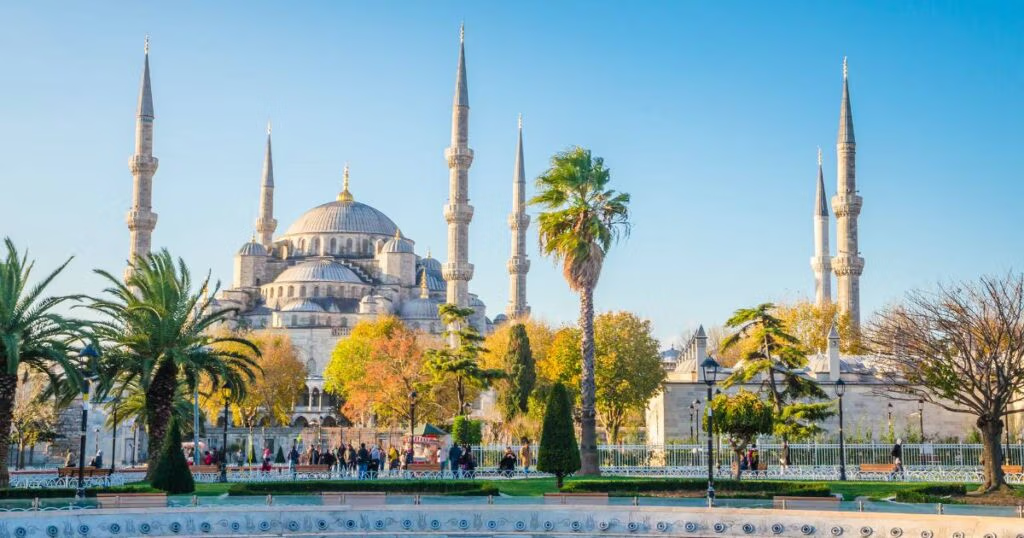
Nestled in the heart of Istanbul, the Blue Mosque, officially known as the Sultan Ahmed Mosque, stands as a magnificent testament to the architectural brilliance of the Ottoman Empire. With its six minarets and cascading domes, the mosque is not only a place of worship but also a symbol of Turkey’s rich cultural heritage. This blog will guide you through the historical and architectural significance of the Blue Mosque, along with practical information for planning your visit, including admission details, opening times, and top tips to enhance your experience.
Historical and Architectural Significance
The Blue Mosque was commissioned by Sultan Ahmed I and constructed between 1609 and 1616 under the direction of architect Sedefkâr Mehmed Ağa. The mosque was intended to rival the grandeur of the Hagia Sophia, which stands just across Sultanahmet Square. Combining traditional Islamic architecture with Byzantine elements, the Blue Mosque is a masterpiece of design and engineering.
The mosque’s interior is adorned with over 20,000 handmade İznik tiles in varying shades of blue, which give the mosque its popular name. These tiles feature intricate floral and geometric patterns that reflect the peak of Ottoman tile-making artistry. The mosque’s large central dome, flanked by smaller domes, creates a spacious interior that is both imposing and serene.
Admission Details
Visiting the Blue Mosque is a must for anyone traveling to Istanbul, and the good news is that entrance is free. However, donations are appreciated and go towards the maintenance and preservation of this historic site. Keep in mind that the mosque is a functioning place of worship, and visitors are required to respect the sanctity of the space.
While there is no admission fee, there are certain rules and etiquette to be followed. Visitors should dress modestly, with long trousers or skirts, and women are required to cover their heads with a scarf. Scarves and skirts are available at the entrance for those who do not have appropriate attire.
Opening Times
The Blue Mosque is open to visitors every day, but it is important to note that it closes to tourists during prayer times, which occur five times a day. The best times to visit are between the prayer sessions: mid-morning, early afternoon, or late afternoon. During Ramadan, the mosque might have different visiting hours, so it is advisable to check in advance.
On Fridays, the mosque closes for a longer period to accommodate the larger congregation for the Friday prayers. Arriving early in the morning or later in the afternoon can help you avoid the crowds and enjoy a more peaceful experience.
Top Tips for Visiting
To make the most of your visit to the Blue Mosque, consider the following tips:
- Plan Your Timing: Arrive early in the morning or late in the afternoon to avoid peak tourist hours. This will allow you to explore the mosque at a leisurely pace and take in the architectural details without feeling rushed.
- Dress Appropriately: As the mosque is a place of worship, dressing modestly is important. Wearing easily removable shoes can also save you time, as you will need to remove them before entering the mosque.
- Photography Guidelines: While photography is allowed inside the mosque, it is respectful to avoid taking photos during prayer times. Be mindful of other visitors and worshippers when taking pictures.
- Explore the Surroundings: After visiting the mosque, take some time to explore the surrounding area. The Hagia Sophia, Topkapi Palace, and the Basilica Cistern are all within walking distance and offer a deeper insight into Istanbul’s history.
- Enjoy the Courtyard: The mosque’s courtyard is one of the largest of its kind, featuring a beautiful fountain and an impressive view of the mosque’s facade. It’s a great spot for taking photos and appreciating the mosque’s grand exterior.
- Guided Tours: Consider joining a guided tour to gain a more comprehensive understanding of the mosque’s history and significance. Knowledgeable guides can provide fascinating insights that bring the mosque’s past to life.
Conclusion
The Blue Mosque is not just an architectural marvel; it is a living symbol of Istanbul’s rich cultural and religious history. Whether you are drawn to its stunning design, its spiritual atmosphere, or its historical importance, a visit to the Blue Mosque promises to be a memorable highlight of your time in Istanbul. By planning your visit with these practical tips and information, you can fully appreciate the beauty and significance of this iconic landmark.
